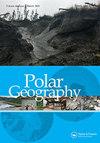Future Arctic regulatory interventions: discussing the impact of banning the use of heavy fuel oil
IF 1.6
Q3 GEOGRAPHY, PHYSICAL
引用次数: 0
Abstract
ABSTRACT The on-going reduction of sea-ice in the Arctic is now facilitating maritime activities in areas previously considered inaccessible. Numerous statistics indicate that fishing and tourism are clearly gaining momentum within the wider region under discussion. Furthermore, a certain number of private companies and state-affiliated actors are setting into motion plans for promoting the use of the so-called arctic passages, while certain interesting business projects are already underway; the Yamal LNG Project is for example clearly standing out. As human presence and operations are expected to intensify within that inherently risky region, the first aim of this paper is to qualitatively identify certain business opportunities associated with the Arctic and then highlight their interrelation with the prevailing patterns of maritime traffic. Additionally, on the basis of the report titled ‘Arctic Shipping Status Report – Heavy Fuel Oil (HFO) Use by Ships in the Arctic 2019' (ASSR #2) that was released during October 2020 by the Arctic Council's Working Group on the Protection of the Arctic Marine Environment (PAME), it explains the use of the various types of fuels in the region under discussion and highlights certain environmental risks. Finally, it briefly assesses the overall effectiveness of a (proposed) regulatory intervention of completely banning the use of HFO in the Arctic. This initiative can indeed have a positive contribution to protecting the region's pristine environment, but any regulations of this type must also consider the issue of fishing vessels, which are not covered under the scope of International Maritime Organization's (IMO) International Convention for the Safety of Life at Sea (SOLAS) and the International Convention for the Prevention of Pollution from Ships (MARPOL).北极海冰的持续减少正在促进以前被认为无法进入的地区的海洋活动。许多统计数字表明,渔业和旅游业显然正在讨论的更广泛区域内获得发展势头。此外,一定数量的私营公司和国家附属机构正在制定促进使用所谓北极通道的计划,而某些有趣的商业项目已经在进行中;例如,亚马尔液化天然气项目就非常引人注目。由于人类的存在和业务预计将在这个固有的风险区域内加强,本文的第一个目的是定性地确定与北极相关的某些商业机会,然后强调它们与现行海上交通模式的相互关系。此外,根据北极理事会保护北极海洋环境工作组(PAME)于2020年10月发布的题为《北极航运状况报告——2019年北极船舶使用重燃料油》(assr# 2)的报告,该报告解释了所讨论地区各种燃料的使用情况,并强调了某些环境风险。最后,简要评估了完全禁止在北极使用重油的(拟议的)监管干预的总体有效性。这一倡议确实可以对保护该地区的原始环境作出积极贡献,但任何此类法规都必须考虑到渔船问题,因为渔船不在国际海事组织(IMO)的《国际海上人命安全公约》(SOLAS)和国际防止船舶污染公约(MARPOL)的范围内。
本文章由计算机程序翻译,如有差异,请以英文原文为准。
求助全文
约1分钟内获得全文
求助全文
来源期刊

Polar Geography
GEOGRAPHY, PHYSICAL-
CiteScore
5.30
自引率
0.00%
发文量
13
期刊介绍:
Polar Geographyis a quarterly publication that offers a venue for scholarly research on the physical and human aspects of the Polar Regions. The journal seeks to address the component interplay of the natural systems, the complex historical, political, economic, cultural, diplomatic, and security issues, and the interchange amongst them. As such, the journal welcomes comparative approaches, critical scholarship, and alternative and disparate perspectives from around the globe. The journal offers scientists a venue for publishing longer papers such as might result from distillation of a thesis, or review papers that place in global context results from coordinated national and international efforts currently underway in both Polar Regions.
 求助内容:
求助内容: 应助结果提醒方式:
应助结果提醒方式:


